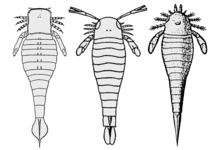Pterygotoidea
| Pterygotioidea Temporal range: Early Silurian - Middle Devonian, 442–391 Ma |
|
|---|---|
 |
|
| Representatives of the three pterygotioid families (from left to right); Slimonidae (Slimonia), Pterygotidae (Erettopterus) and Hughmilleriidae (Hughmilleria). | |
| Scientific classification | |
| Kingdom: | Animalia |
| Phylum: | Arthropoda |
| Subphylum: | Chelicerata |
| Class: | Merostomata |
| Order: | †Eurypterida |
| Infraorder: | †Diploperculata |
| Superfamily: |
†Pterygotioidea Clarke & Ruedemann, 1912 |
| Type species | |
|
†Pterygotus anglicus Agassiz, 1844 |
|
| Families | |
| Synonyms | |
|
|
Pterygotioidea (or pterygotioids, the name deriving from the type genus Pterygotus, meaning "winged fish") is a superfamily of eurypterids, an extinct group of aquatic arthropods commonly known as "sea scorpions". They were members of the infraorder Diploperculata, in the suborder Eurypterina. The Pterygotioidea superfamily contains the highly derived family Pterygotidae, famous for their robust and powerful cheliceral claws, as well as the more basal genera of the families Slimonidae and Hughmilleriidae.
Among the currently recognized eurypterid clades, Pterygotioidea is the most diverse, containing over 50 species in 10 genera. With there being around 250 recognized valid species of eurypterids, the group accounts for more than a fifth of all known eurypterid species. Though the group only existed for around 50 million years and during a time when most continents were separated by large expanses of water (in contrast with previous and later periods of time when there had been supercontinents), the Pterygotioidea had the most cosmopolitan distribution of all recognized eurypterid groups. Their fossils have been recovered from Europe, Africa, North America, South America, Asia and Australia, with the earliest remains being from the Early Silurian of Scotland and South China. The exact geographical origin of the group remains unknown, but is thought to have been in Laurentia.
Pterygotioids can be distinguished from all other eurypterine eurypterids by the placement of their eyes, being located near or in some cases on the margin of the carapace (the "head" plate).
...
Wikipedia
